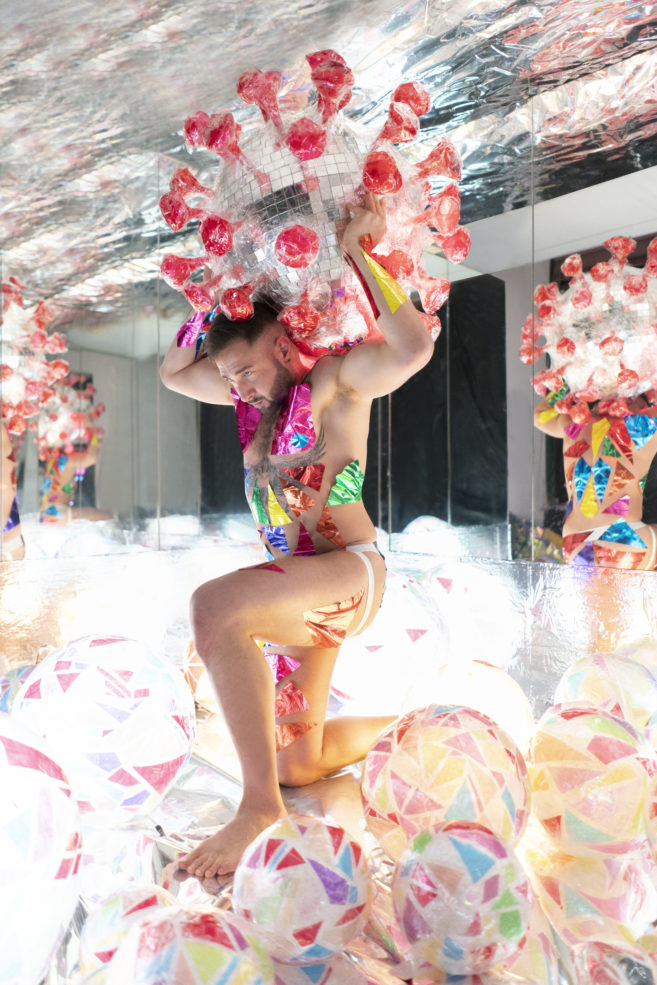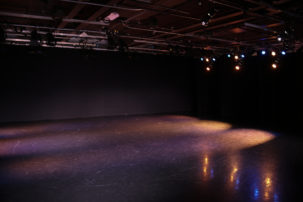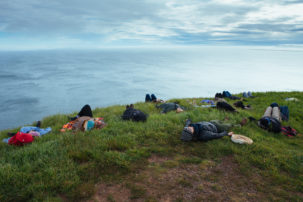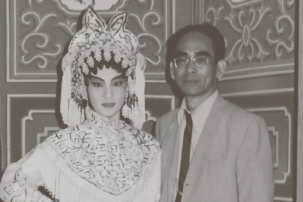It was beautifully cool, first and foremost; it was also quiet. For a 16-year-old cutting class and killing time before a dreaded telemarketing shift, there was no better place. In those days—the early 2000s—the Art Gallery of Hamilton was free to the public. Perhaps more important was that entering required only the barest scrutiny by the front-desk greeter. That this was the year I was first diagnosed with—among other things—agoraphobia, only highlights how healing that place was to me at a raw, formative moment. It was roughly at this time that I also started concretizing my career goal. Although I may not have posed it so flippantly in those days, what I really wanted was just to be left alone with the art.
Our focus has slowly shifted from questions about survival to questions about sustainability—about how to operate responsibly within a context of ongoing crises.
Twenty years later, I have loved those moments when install for an exhibition goes long (or wrong) and I can witness the slow emptying of the MacLaren Art Centre, the museum I now work at, in Barrie. Gallery visitors can’t know how the summer evening sunlight pours sideways through the clerestory windows at 8 p.m. or how the skylight in the Janice Laking Gallery glows Prussian blue when the winter twilight meets the warm track lighting in December. I cried when we locked up on March 16, after our staff left with enough files to sustain what we thought would be a three-week absence. The building held its usual ticking, settling, calming quiet, but this was different. Even then, some part of me knew that little would remain the same when we reopened.
I started writing this essay during a record-breaking heat wave in May and finished as cities across the world protested the deaths of George Floyd, Regis Korchinski-Paquet and many other Black lives lost to police violence and systemic social failures. The MacLaren is still closed, as are so many city facilities and parks; in this, we are no different, lately, than many other regional public art galleries in comparable municipalities throughout Canada. While we gallery staff are still reeling from all that’s happened, our focus has slowly shifted from “What now?” to “What next?”—questions not about survival, but about sustainability, and about how to operate responsibly within a context of ongoing crisis. Or, more accurately, how to operate within a Gordian Knot of ongoing crises, most of which predate COVID-19 and have only been intensified by its unequal, ugly spread.
This crisis of public space, including who penalized for being in it, is a crisis with a long and pernicious history.
The crisis I address here is that of public space: while our focus now might be in building policies to mitigate the spread of COVID-19 within our walls, the imperative to reopen lies largely in the fact that we are nothing without an audience. Prior to the pandemic, we were open seven days a week, operating within a beautifully porous building designed more for museum visitors than museum professionals. The space’s use was informal: come an ordinary May, I might find teenagers in prom dresses posing for selfies in the galleries, school groups piling their bookbags in our back office area before a tour, couples on second dates lingering in our interior courtyard an hour after our street-side café closed. The porousness of the building is now its main challenge in reopening: in consideration of built-in bottlenecks—such as a single, central staircase linking all three floors—I’ve proposed that for the first few weeks after reopening, we allow 10 per cent of our pre-pandemic 350-person capacity. And while 10 per cent might seem too low to have any real impact on our community, I’ve seen what happens to a city when its public spaces shut down.
There were the anticipated impacts of shutting down in March: the loss of earned revenue from our café and Gallery Shop; the loss of fundraising revenue from our annual spring gala. There were the shows that were days away from opening that no one saw; the artwork from a previous season that couldn’t be returned on the normal east-west shipping runs from Toronto to Vancouver. And then there were the impacts I didn’t anticipate: the impact of shutting down some of the only free, clean gender-neutral public bathrooms in the city; the consequences of locking up the naloxone kit, the defibrillator. While indoor public spaces closed in successive waves, the play structures and benches in public parks were one morning suddenly draped in caution tape so gaudy yellow it made the slow-to-come spring seem even crueller. In the interim, our team remained at home, creating what free digital programming we could for the Barrie residents who have access to reliable internet (fewer than you might think).
While public space largely emptied, the discourse surrounding it was full and fraught. Here, as is the case elsewhere, people with the freedom to do so have individually balanced the risks between staying at home and going outside or to work. Here, again as is the case elsewhere, the repercussions for breaking self-isolation were unevenly felt. While there was no Trinity Bellwoods incident here in Barrie to serve as what Shree Paradkar calls “a quick snapshot as to who feels entitled to the public space [and] who gets scrutinized and who gets penalized for existing in it,” I can anecdotally attest to the uncomfortable nature of public space here during the emergency closures. Of course, this crisis of public space, including who is scrutinized and penalized for being in it, is again a crisis with a much longer and more pernicious history: from the MacLaren, you need only walk two blocks down Dunlop Street and turn left on Bayfield Street to come across a memorial to Olando Brown, tenderly maintained since his death in police custody in 2018.
For many who, like me, navigate the world with multiple overlapping privileges, fear of public space is rare. But the virus has punctured our easy confidence in the world at large, and the perception of our safety within it. The MacLaren will open its doors in the summer to audiences that will include those who are new to trauma, still processing all that’s happened since March and fearful of what’s yet to come. Indeed, the best model I’ve heard proposed for organizations moving forward with reopening is one adopted from medicine: trauma-informed care. With a focus on five guiding principles—safety, choice, collaboration, trustworthiness and empowerment—this model could set a tone for organizations not only now, but moving forward. COVID-19 could be the shift we need to finally recognize trauma as the results of systems—systems that include and are upheld by museums and galleries rather than individuals. The model acknowledges that many visitors—including staff and volunteers—are for many reasons rightfully distrustful of these spaces.
We must create new metrics of success to replace those that once seemed so inevitable…What’s most important is that we don’t recreate what wasn’t working.
Fear of infection is nothing compared to the fear of violence in public space. Museums and galleries, as public spaces and as privileged sites of settler colonial knowledge production, have participated in the violent exploitation and exclusion of BIPOC for hundreds of years. COVID-19 has reinforced many exclusions; it has also offered the closest thing to a clean slate that we’re going to get. We will—and should—be judged for how we move forward. With mutuality and respect, we must create new models for working and new metrics of success to replace those that once seemed so inevitable, necessary and natural. What’s most important is that we don’t recreate what wasn’t working.
I am going to say this as simply and as humbly as I can: these problems feel bigger than my ability to solve them. One of the many difficult realities of reopening is that we’re being asked to reintroduce some barriers to access that we’ve spent years removing. At the MacLaren, we’re small enough that we can avoid some of the most onerous ones, and instead are introducing dedicated times for elderly and immunocompromised visitors; strict directional movement through the space; PPE for visitors; a sharp reduction in touch-screens and other accessible information carriers; the removal of public seating; and queuing for bathrooms limited to single stalls—it’ll feel complicated, but I’m hoping our measures will demonstrate care, not distrust. Central to our plan is a robust anti-bullying and anti-harassment policy. At a moment when we’re being asked to create stringent protocols for reopening, we should be doubling down on anti-oppression techniques and training. Galleries may never not be settler institutions, but they don’t have to revert back to being temples on hills.
One of the chief advantages we have at the MacLaren is that we are housed in public space. While we are incorporated separately from the City and receive only 20 per cent of our operational support from government funding at all levels, we have avoided many of the public-private hybrid spaces that have become so prevalent in our field in recent years. This makes me hopeful that when we reopen, we can trade off with other places in Barrie: the libraries, the recreational centres, the cooling stations. All will struggle with capacity, just as we will. And as one of only two free, indoor public spaces in the Barrie downtown core, I suspect we might be needed now more than ever.
Buildings need to be lived in to thrive—it’s a necessary kind of entropy.
Regardless of someone’s reasons for visiting the MacLaren—whether it’s to get cool on a sweltering day like the record-breaking ones we experienced in the last weeks of May, or to use a non-gendered public bathroom free from unnecessary scrutiny—I hope that they experience what I did as a teenager seeking solace two decades ago. We have some great work up: Joyce Weiland drawings from the early 1980s as wild and wicked as a sly look from that aunt you idolize; a Carl Beam (Learning to See, 1997) with a spectral splash of varnish on its luminous gold surface, visible only under raking light. Connections with works like these—I hope—foster pride of place, a sense of belonging.
These days, when I visit the MacLaren twice weekly to check the collections and exhibitions, and to supervise needed maintenance, the building has the unbreathed air of my grandparents’ house after it was abandoned. Buildings need to be lived in to thrive—it’s a necessary kind of entropy. When I was younger, I just wanted to be alone with the art, but now that seems like an odd threat, a nightmare inversion of an old dream. It’s not that I no longer treasure my moments alone there, only that I’m hopeful people will come back again, and soon.

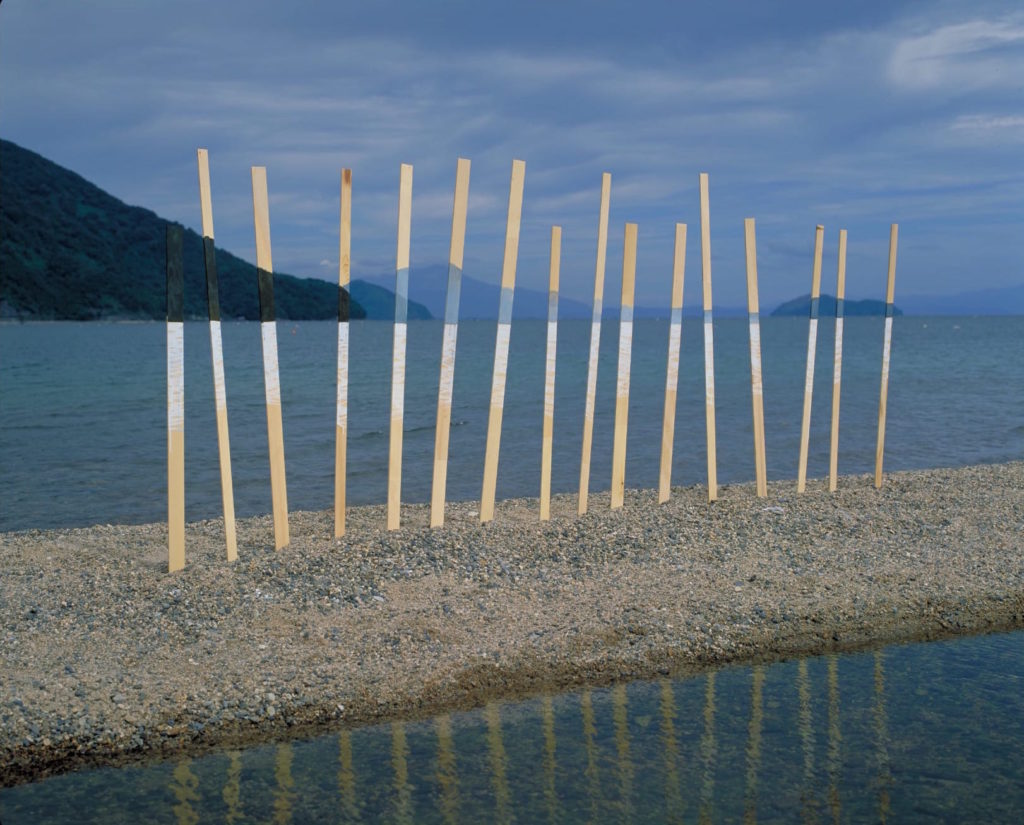 Akira Komoto, seeing 90-10 (detail), 1990. Chromogenic print, 47.2 x 70.8 cm. Collection the Maclaren Art Centre. Gift of the artist, 1996. Photo: Andre Beneteau
Akira Komoto, seeing 90-10 (detail), 1990. Chromogenic print, 47.2 x 70.8 cm. Collection the Maclaren Art Centre. Gift of the artist, 1996. Photo: Andre Beneteau
